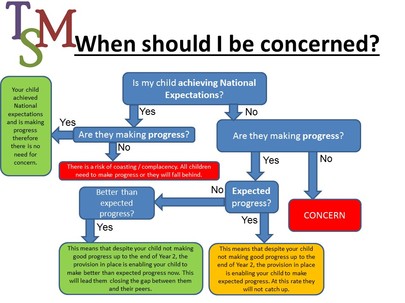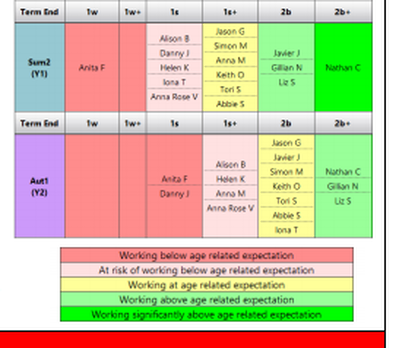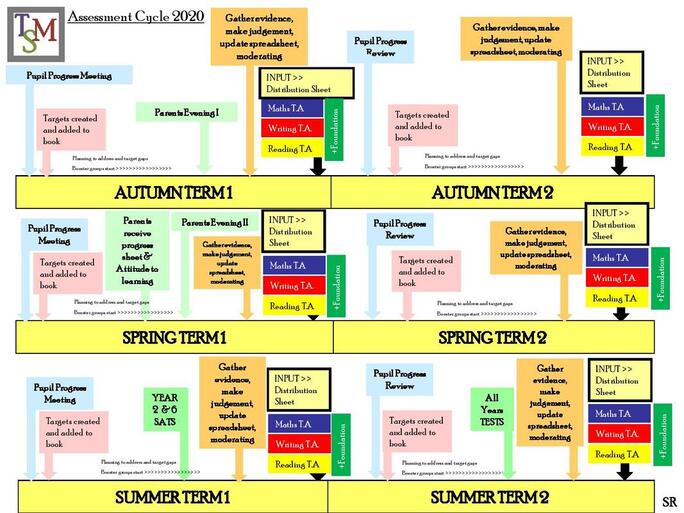assessment at Trimley st martin
ASSESSMENT LEADER - MRS Ross
If you have any questions about Assessment speak with Mrs Ross
| Assessment Policy 2023 | |
| File Size: | 1395 kb |
| File Type: | |
ASSESSMENT
Assessment is integral to high quality teaching and learning and lies at the heart of the process of promoting children’s learning at Trimley St Martin Primary School. It helps us to ensure that teaching is appropriate and that learners are making expected progress. It provides a framework for setting educational objectives, monitoring and communicating children’s progress. At Trimley St Marin Primary School, assessment must be a part of all teaching strategies, to help identify areas for development and track progress. It helps us to strengthen learning across the curriculum and helps teachers enhance their skills and judgments so that all learning is personalised to enable all children to make progress in each lesson.
The TSM Assessment process has 3 clear aims:
a) Clarity for pupils, parents and carers- We use our assessment systems to support informative and productive conversations with pupils and parents. Our clear assessment process enables pupils to take more responsibility for their achievements by encouraging them to reflect on their own progress, understand what their strengths are and identify what they need to do to improve very easily. Making sure that our assessment is linked to the content of the school’s curriculum will allow for communications with parents to provide a clear sense of how to support their children to build and consolidate learning. We will be able to pin point the areas that pupils are struggling with.
b) Support for pupils- We focus on providing pupils with feedback which highlights the aspects of the curriculum where their knowledge and understanding is secure and those areas where there are gaps. Using a range of formative assessment methods allows our teachers to tailor their assessments to the underpinning knowledge and skills being taught.
c) Teacher workload- At Trimley St Martin we want teachers to build their confidence in using a range of formative assessment techniques without the burden of unnecessary recording and tracking.
Purpose- At Trimley St Martin Primary School we believe that we are assessing the children for two key purposes:
The Assessment Process- Our assessment will enable the school to measure how secure children are with regards to working at the standard expected for their age. Our assessment process will also enable us to identify the children who are secure in the year group expectations and those who are working at greater depth.
Our assessment system aims to alert the teacher to the areas in which a child is secure but also highlight areas of the curriculum that need further support, re-teaching or consolidation.
Each half term, teacher will record how many of the year group expectations a child is secure in. The school believes that if a child is secure in 95% - 100% of the expectations then they are in fact classed as achieving the expected standard for their age. This information will be added to our tracking system, which will allow the school to see the following:
The TSM Assessment process has 3 clear aims:
a) Clarity for pupils, parents and carers- We use our assessment systems to support informative and productive conversations with pupils and parents. Our clear assessment process enables pupils to take more responsibility for their achievements by encouraging them to reflect on their own progress, understand what their strengths are and identify what they need to do to improve very easily. Making sure that our assessment is linked to the content of the school’s curriculum will allow for communications with parents to provide a clear sense of how to support their children to build and consolidate learning. We will be able to pin point the areas that pupils are struggling with.
b) Support for pupils- We focus on providing pupils with feedback which highlights the aspects of the curriculum where their knowledge and understanding is secure and those areas where there are gaps. Using a range of formative assessment methods allows our teachers to tailor their assessments to the underpinning knowledge and skills being taught.
c) Teacher workload- At Trimley St Martin we want teachers to build their confidence in using a range of formative assessment techniques without the burden of unnecessary recording and tracking.
Purpose- At Trimley St Martin Primary School we believe that we are assessing the children for two key purposes:
- To identify strengths in subject areas and to identify gaps in learning which can then planned for and addressed.
- To ensure children are meeting and achieving the expected standard and that they are making good progress whilst being in the school.
The Assessment Process- Our assessment will enable the school to measure how secure children are with regards to working at the standard expected for their age. Our assessment process will also enable us to identify the children who are secure in the year group expectations and those who are working at greater depth.
Our assessment system aims to alert the teacher to the areas in which a child is secure but also highlight areas of the curriculum that need further support, re-teaching or consolidation.
Each half term, teacher will record how many of the year group expectations a child is secure in. The school believes that if a child is secure in 95% - 100% of the expectations then they are in fact classed as achieving the expected standard for their age. This information will be added to our tracking system, which will allow the school to see the following:
- The children are likely to exceed the year group expectation- Secure+ / Greater Depth)
- The children who are on-track / likely to achieve the national expectation - SECURE
- The children who are unlikely to achieve the national expectation- Beginning (+) / Working Within (+) After each term, our tracking system will enable the school to identify those who are making good progress to achieving the national expectation, those who are making rapid progress and those who are making slower progress.
SCHOOLS APPROACH TO ASSESSMENT
Year Group Expectations
The ASSESSMENT PROCESS
Reading, Writing and Maths will be assessed by teacher judgement and evidence of learning that the children are showing in their books, through questioning and discussion and in summative tests. This is an ongoing process.
At the beginning of a new academic year, as children are being judged against the End of Year expectations, they will be only be beginning to develop their knowledge . By using professional knowledge and judgement teachers will know what the children can already do and what they think the children can achieve. At different stages across the school year, children will either be 'working towards the National expectation' for their year group, 'achieving the National expectation' or 'Exceeding' the national expectation.
The Government have said that at least 85% of children should be 'achieving the National Expectation' by the end of the academic year.
At the beginning of a new academic year, as children are being judged against the End of Year expectations, they will be only be beginning to develop their knowledge . By using professional knowledge and judgement teachers will know what the children can already do and what they think the children can achieve. At different stages across the school year, children will either be 'working towards the National expectation' for their year group, 'achieving the National expectation' or 'Exceeding' the national expectation.
The Government have said that at least 85% of children should be 'achieving the National Expectation' by the end of the academic year.
High achievers will work on the mastery element of the curriculum; once achieving the National Expectation for their year group. They will not move on to objectives from the year group above. They work work at gaining "Greater Depth".
BELOW THE NATIONAL STANDARD

Those children who are significantly below the national expectation will be included in this category. For some children they will be levelled using the "Engagement Model. Other children who are significantly behind can be graded against year group expectations below their own and that of Pre-Key Stage Standards. This will normally be EHCP or children with profound learning needs. All other children should be working towards their own year group objective.
REPORTING TO PARENTS ABOUT ATTAINMENT AND PROGRESS
During the year, we will have conversations with parent's/carer's about a child’s progress. We will share the progress seen in children's work, we will talk through where the strengths and gaps are in a child’s learning and how this compares to the expectation for the year group the child is in.
The school will use a pupil progress report to share assessment information with parents. Each full term this information will be updated to indicate how a particular child is progressing with the year group expectations.
The school will use a pupil progress report to share assessment information with parents. Each full term this information will be updated to indicate how a particular child is progressing with the year group expectations.
TEACHER RECORDING & MONITORING
Every half term the teachers will collate their notes, their annotated plans, photographs, work produced by the children, assessments and work in children's Literacy and Maths books and sit down to decide which children are secure in particular expectations. They will use this information to enter data into the school's on-line tracking system: 'Target Tracker'.
Teachers will then be able to analysis which children are working at expected and rates of progress.
The colour coding in the box shows the expected progress through the different steps. Children in the yellow section will be considered to be on track to meet the expectations. Those in the green section would be making above the expected progress and those in the pink would need to be focused on very carefully.
Teachers will then be able to analysis which children are working at expected and rates of progress.
The colour coding in the box shows the expected progress through the different steps. Children in the yellow section will be considered to be on track to meet the expectations. Those in the green section would be making above the expected progress and those in the pink would need to be focused on very carefully.
PUPIL PROGRESS MEETINGS & INTERVENTION GROUPS
The tracking sheet will be used to identify children who need intervention and those who are risk of not meeting the year group expectations.
Those in the pink boxes will be identified first. The class teacher and the Assessment lead will then use the information to identify the focus of the interventions (Wave 1 Classroom, Wave 2 Booster, Wave 3 1:1 or specialist support). In the example above the focus of the intervention group might be number bonds and subtraction facts within 20. This may be re-visited in class as clearly the children didn’t understand it as well as it becoming the focus of booster groups too.
Those in the pink boxes will be identified first. The class teacher and the Assessment lead will then use the information to identify the focus of the interventions (Wave 1 Classroom, Wave 2 Booster, Wave 3 1:1 or specialist support). In the example above the focus of the intervention group might be number bonds and subtraction facts within 20. This may be re-visited in class as clearly the children didn’t understand it as well as it becoming the focus of booster groups too.






